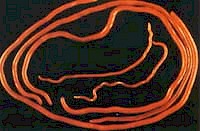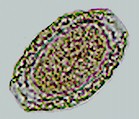Dioctophyma renale, the giant kidney worm, is a parasitic roundworms that has dogs (occasionally also cats) and numerous other carnivores as final hosts, especially those that feed regularly on freshwater fish (e.g. minks, otters, etc.).
that has dogs (occasionally also cats) and numerous other carnivores as final hosts, especially those that feed regularly on freshwater fish (e.g. minks, otters, etc.).
It is found worldwide, less frequently in Asia and Oceania. Incidence in dogs is low (usually <1%), even in endemic areas. Incidence in fish-eating animals may be especially high, e.g. ~50% of the minks where found to be infected in a study in Ontario (Canada).
Dioctophyma renale is one of the largest helminths known: it can be longer than 1 meter.
The disease caused by Dioctophyma renale is called dioctophymiasis.
Are dogs or cats infected with Dioctophyma renale contagious for humans?
- NO. Not through contact with the pets, nor through their feces or the vomit. Although Dioctophyma renale can parasitize humans, the eggs shed by infected dogs and cats are not directly infective for humans. They have to spend some time in the environment and be eaten by intermediate hosts to become infective. Humans become infected after eating raw or unsufficiently cooked fish or frog. For additional information read the chapter on the life cycle below.
This worm does not infect cattle, sheep, goats, pigs, horses or poultry.
You can find additional information in this site on the general biology of parasitic worms and/or roundworms.
Final location of Dioctophyma renale
Predilection sites of Dioctophyma renale are the kidneys, usually only the right kidney.
Anatomy of Dioctophyma renale

Dioctophyma renale is one of the largest roundworm known. Males are 20-40 cm long and 5-6 mm thick. Females can be up to 1 meter long and 12 mm thick. They have a pink to reddish color. Otherwise, as other roundworms their body is covered with a cuticle, which is flexible but rather tough.
The worms have no external signs of segmentation. They have a tubular digestive system with two openings. They also have a nervous system but no excretory organs and no circulatory system, i.e. neither a heart nor blood vessels. Males have chitinous spicules for attaching to the female during copulation.
The eggs (~45x70 micrometers) have an oval shape and a thick shell characteristically structured, and are embryonated.
Life cycle and biology of Dioctophyma renale
Dioctophyma renale has an indirect life cycle, with dogs, cats and other carnivores as final hosts, and aquatic worms (so called Oligochaeta, e.g. Lumbriculus variegatus) as intermediate hosts.
Adult females lay eggs that are shed with the host's urine. They mature in water in 2 to 10 weeks and can remain infective for months. Aquatic worms eat these eggs, which develop to L3 larvae in the body of the aquatic worms. Fish, crustaceans (e.g. crabs), frogs or other amphibians act as transport hosts (=paratenic hosts): they eat these worms, the L3 larvae are released in their stomach and subsequently they encyst in their tissues. Dogs, cats and other final hosts become infected by ingesting infected aquatic worms (e.g. when drinking water) or transport hosts.
In the final host L3 larvae are released in the stomach. They migrate to the liver where they mature during about 2 months to become juvenile adults. Subsequently they migrate to the kidneys through the peritoneal cavity. In most cases only the right kidney becomes infected, perhaps because it is closer to the stomach and the liver. There they reach sexual maturity and reproduce. In case of massive infections both kidneys may be infected. Occasionally some worms do not reach the kidneys and complete development in the peritoneal cavity.
Adult worms can live for up to 5 years inside the final host. They feed on kidney tissues and blood.
Harm caused by Dioctophyma renale infections, symptoms and diagnosis
Dioctophyma renale can cause massive damage to the affected kidney. The destroyed tissues are replaced by connective tissue (fibrosis), which substantially impairs normal kidney functioning. Since usually only one kidney is affected, the other one takes over and the infected pet shows no clinical signs. In seldom cases where both kidneys are severely affected, nephritis (inflammation of the kidney), bloody urine, and renal colic (if the worms get into the urethra) can occur; fatalities are possible due to renal failure. Worms that remain in the peritoneal cavity can cause peritonitis (inflammation of the peritoneum), but also hepatitis (inflammation of the liver) and ascites (accumulation of fluid in the peritoneal cavity).
Diagnosis is often done only during post-mortem examination, or during surgery for other reasons. Typical eggs can be found in the urine sediment, but false negatives are possible because egg shedding is intermittent and it can also happen that only female worms infect the animal: they won't lay eggs in absence of male worms. Kidney ultrasound echography is usually a reliable method to visualize the adult worms in the kidneys.
Prevention and control of Dioctophyma renale
Best prevention in endemic regions (e.g. where industrial or traditional freshwater fishing is practiced) is to prevent dogs and cats from feeding raw fish, frogs, crabs, etc. and from scavenging on fish waste.
Surgical removal is the most common treatment once infection has been confirmed. Among the common anthelmintics, there are a few reports that fenbendazole is effective against larvae, and ivermectin against adults in the kidneys. However, most common pet wormers are not approved for this use. Therefore, ife ever tried, the veterinary doctor has to determine a special treatment regime.
There are so far no true vaccines against Dioctophyma renale. To learn more about vaccines against parasites of livestock and pets click here.
Biological control of Dioctophyma renale (i.e. using its natural enemies) is so far not feasible.
You may be interested in an article in this site on medicinal plants against external and internal parasites.
Resistance of Dioctophyma renale to anthelmintics
So far there are no reports on resistance of Dioctophyma renale to anthelmintics.
This means that if an anthelmintic fails to achieve the expected efficacy, chance is very high that either the product was unsuited for the control of Dioctophyma renale, or it was used incorrectly.
|
Ask your veterinary doctor! If available, follow more specific national or regional recommendations for Dioctophyma renale control. |